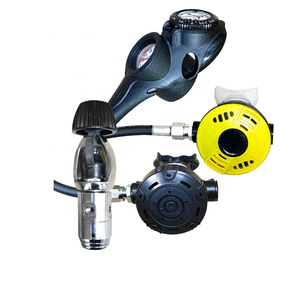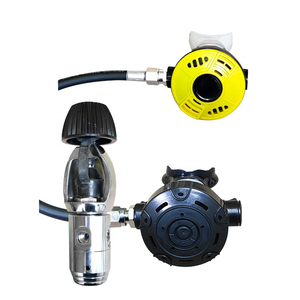(1100 products available)









































































































































































A depth gauge for diving is an important tool that divers use to measure how deep underwater they are. This tool is really important for safety and for making sure that divers can do their job well. Here are the main types of depth gauges:
Mechanical Depth Gauge
This type of depth gauge for diving does not use batteries or any electronic parts. Instead, it uses water pressure to move a needle on a dial and show how deep the diver is. These gauges are known for their toughness and reliability, even in difficult diving conditions. They are also very simple to use and read, which makes them a preferred choice among divers who like traditional tools. However, they might not have some of the extra features that electronic gauges offer, and their readability can sometimes be an issue in low-light conditions.
Electronic Depth Gauge
This is a kind of digital depth gauge that shows how deep the diver is using numbers on a screen. They are known for their precision and clarity, which makes them easy to read. This is especially true in places with low light. Many electronic depth gauges also come with extra features like the ability to keep a record of how deep one has gone and an alarm that goes off when one goes too deep. On the downside, these devices require batteries to function, and they can be sensitive to impact.
Combined Depth and Pressure Gauge
This device shows both the depth and the pressure at the same time. It is very useful for divers because it helps them monitor how deep they are and the pressure at the same time. These combined gauges save space and are convenient, especially in tight areas. They are usually found in high-end dive computers or as separate gauges in premium diving kits. Nevertheless, if one part of the gauge fails, the whole system may be affected.
Depth Gauge Computers
Dive computers are advanced devices that monitor depth, time, and other vital factors. They can also track how long one has been diving and how deep one has gone. These devices are great because they give detailed information that can help with safe diving. They also have features like a logbook and an alarm system. Conversely, they are usually more expensive and can be complicated to use.
Depth gauges are vital tools that find various applications across different fields and activities. Here are some common usage scenarios:
Recreational Diving
In recreational diving, depth gauges determine the depth of divers. This ensures that they are safe and within the limits of their training and equipment. Also, the gauges are useful in monitoring underwater time and helping divers avoid getting into situations of decompression sickness.
Professional Diving
Professional divers, for instance, commercial or saturation divers, use depth gauges to monitor their depth. The divers often work at significant depths for long hours. Therefore, accurate depth measurement is critical for their safety and operation efficiency.
Underwater Exploration
Depth gauges are used in underwater research and exploration. For instance, marine biologists and archaeologists require precise depth measurements when studying marine life or exploring underwater sites. Moreover, oceanographers use depth gauges to assist in the measurement of ocean depths and monitoring of underwater phenomena.
Search and Rescue Operations
Depth gauges are useful tools during search and rescue operations. This is because they assist divers in locating and retrieving objects or individuals at the bottom of water bodies.
Swimming Pools
In swimming pools, particularly large or competitive facilities, depth gauges measure pool depth. This ensures swimmer safety and compliance with regulatory standards.
Water Sports
In water sports like snorkeling or kayaking, depth gauges monitor water depth. This helps prevent accidents and ensures participants stay within safe limits.
Maintenance and Inspection
Dive depth gauges are important tools for maintenance and inspection. For instance, they are used to check the depth of water in cooling ponds for nuclear reactors or other industrial facilities. This ensures proper function and safety parameters.
Navy and Military Applications
Depth gauges are used during training and operational missions in the Navy and military. This assists in navigation, surveillance, and combat missions.
When selecting a dive depth gauge, several factors should be considered to ensure the right device is chosen for specific diving needs and preferences. Here are some of them:
Depth gauges are essential tools for underwater activities such as diving and fishing. They help divers and underwater explorers stay safe by monitoring how deep they are. Here's a breakdown of their features, functions, and designs:
Pressure Sensor
For electronic gauges, pressure sensors are used to determine the depth. They are precise and work well, even in deep waters.
Backlight Display
A few depth gauges offer backlit displays that make it easy to see in dim underwater conditions. This feature is especially useful for night diving or in murky water.
Water Resistance
All depth gauges are water-resistant. They are tested to ensure they function well at great depths without any leakage.
Data Logging
Depth Measurement
All depth gauges measure depth. This is their primary function. They help divers monitor their depth to avoid issues like decompression sickness.
Depth Alerts
Water Temperature Measurement
Some gauges measure water temperature. Knowing the water temperature is vital for divers because it helps them monitor their diving limits. It is also useful for underwater activities like fishing.
Durability
Depth gauges are made with durable materials. For instance, stainless steel and high-quality plastics can withstand harsh underwater conditions.
Rotatable Bezels
Some depth gauges have rotatable bezels. Divers can use them to track the time spent diving. This feature is useful for free divers who do not have electronic timers.
Compact and Lightweight
Most depth gauges are compact and lightweight. They are easy to wear and do not add unnecessary weight to divers.
Mounting Options
Depth gauges have different mounting options. Some are worn on the wrist like watches, while others can be mounted on dive consoles or gauges.
Q: What is a dive depth gauge?
A: A depth gauge for diving shows the current depth, the maximum depth reached, and sometimes the depth of water.
Q: How does a dive depth gauge work?
A: An analog scuba depth gauge uses water pressure to know how deep the water is. The air inside the gauge contracts as more water pressure is applied. This event moves the needle on the gauge. In the case of a digital depth gauge, a sensor measures the water pressure to give a depth reading.
Q: Why is the dive depth gauge important?
A: The depth gauge is important because it helps divers know how deep they are. This information is important for safety and helps divers do all the things they want to do underwater, like enjoying the view or coming back up safely.
Q: What are the different types of dive depth gauges?
A: There are two main types of dive depth gauges: analog and digital. Analog gauges have needles that show depth with numbers and lines. Digital gauges show depth with numbers on a screen. Depth gauges can also be automatic or manual. Automatic depth gauges track how deep a diver goes all the time. Manual depth gauges need divers to adjust them to show how deep they are.